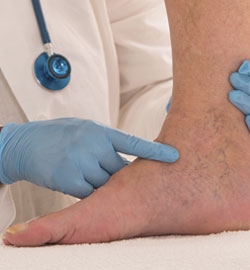Chronic Venous Insufficiency Symptoms and Complications

Often, people think of varicose veins as just a cosmetic problem. In fact, they could be the symptom of a more serious underlying condition. If your varicose veins are accompanied by discomfort such as a heavy, aching sensation, seek medical care. This could be indicative of a condition called Chronic Venous Insufficiency (CVI), which can lead to serious issues like ulcers and cellulitis if left untreated.
- What is Chronic Venous Insufficiency? A vascular condition affecting the legs, CVI occurs when the valves in your veins designed to keep blood flowing in the right direction stop working properly. As a result, blood can flow backward and pool in the legs. CVI is not the same thing as varicose veins, but many people with CVI have visible varicose veins. That’s why it’s important to see a vascular specialist to determine the cause of your varicose veins.
- CVI has several symptoms apart from varicose veins. While dark blue or purple, twisted or bulging varicose veins are one sign of CVI, other symptoms appear as the illness progresses. These include aching or heaviness in the legs, itching, bruising, swelling feet or swollen ankles, brownish skin, eczema, or ulcers.
- Serious complications can arise from untreated CVI.
- Venous stasis ulcers: The poor circulation it causes in your legs can result in the development of ulcers that are painful and slow to heal. During the healing process, a bacterial infection can take hold in the ulcers, causing them to need debridement, antibiotics, or even surgery.
- Deep vein thrombosis (DVT): A condition linked to CVI, DVT causes blood clots to develop in the deep veins of your legs. Not only can these blood clots block blood flow to the leg, but they can also sometimes break off, travel to your lungs, and cause a pulmonary embolism, which can be fatal.
- Bleeding: If you have chronic venous insufficiency and injure your leg, circulation problems can impair the healing process and cause you to bleed heavily. Without immediate medical care, this can be life-threatening. CVI can also cause spontaneous bleeding, which should be reported to a physician right away.
Early treatment of chronic venous insufficiency can help prevent serious health complications. Sometimes you can take steps to manage symptoms and reduce pain, like elevating your legs, wearing compression stockings, exercising, maintaining a healthy weight, and avoiding sitting or standing for long periods. There are also minimally invasive procedures to improve blood flow like radiofrequency vein ablation, endovenous laser therapy, or sclerotherapy. In some cases, surgery may be recommended.
If you’re seeking the very best care for your vein and blood flow issues, trust the board-certified physicians at the Arizona Vein & Laser Institute. Using the most advanced technology, the vascular and cardiovascular surgeons at the Arizona Vein & Laser Institute provide care for all types of venous diseases. With over 40 years of experience, our team of experienced physicians can devise the right treatment plan to address your venous disease problems. For more information contact us through our website.
